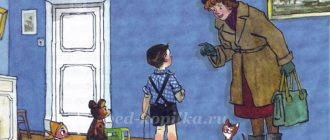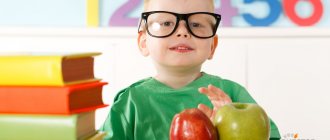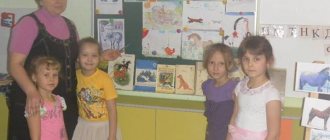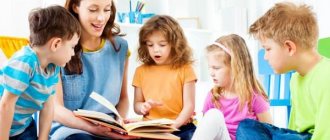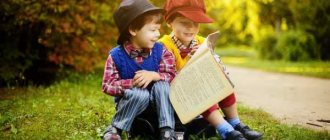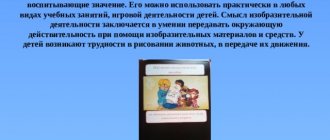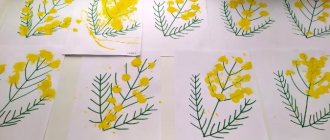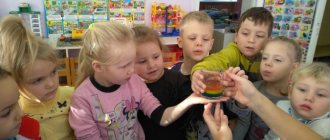Methods and techniques for working with children to familiarize themselves with fiction
• Puppet and shadow theater, flannelgraph.
• Filmstrips, movies, TV shows.
Reading as part of a speech development lesson.
• It can be logically related to the content of the lesson.
• Reading can be an independent part of the lesson.
The main methods are the following
:
1. Reading by the teacher from a book or by heart. This is a literal rendering of the text.
2. The teacher's story. This is a relatively free transfer of text. Storytelling provides great opportunities to attract children's attention.
3. Staging. This method
can be considered as a means of secondary
acquaintance with a work of art
.
4. Learning by heart. The choice of transmission method depends on the genre and age of the listener.
Traditionally in the methodology
speech development, it is customary to distinguish two forms
of working
with books in kindergarten: reading and storytelling.
Children of primary preschool age are taught a love and interest in books and illustrations, the ability to focus attention on the text, hear it to the end, understand the content and respond emotionally to it. Starting from the younger group, children are introduced to the distinction between genres. At this age, children are able to understand and remember a fairy tale and repeat a song, but their speech is not expressive enough.
In middle preschool age, work
to develop in children the ability to perceive
a literary work
, the desire to respond emotionally to the description of an event. Children are taught to answer questions about whether they liked the fairy tale or the story, what it is about, what words it begins and ends with.
In older preschool age, a strong interest in books arises and a desire to listen to them read. Accumulated life and literary
experience gives the child the opportunity to understand the idea of the work, the actions of the characters, and the motives of behavior.
Children begin to consciously
relate to the author's word, notice the features of language, figurative speech and reproduce it.
The main role in training belongs to special classes. Classes are supplemented and interact with special didactic games outside of class.
Introduction to fiction
cannot be limited to classes. Reading and storytelling of books is organized at all moments of the life of children in kindergarten; it is associated with games and walks, with everyday activities, and work.
In order to develop children's interest in fiction
a literary center
is created in each group , this is a calm, comfortable, aesthetically designed place where children have the opportunity to communicate with books, look at illustrations, magazines, and albums. There are a number of requirements for the installation of a corner:
From methodology to practice of working with text in preschool educational institutions
Nadezhda Smirnova
From methodology to practice of working with text in preschool educational institutions
The relevance of this topic is due to a fundamentally new phenomenon introduced into pedagogical practice by the standards of the second generation of primary education. We are talking about meta-subject results, which are understood as methods of activity mastered by students on the basis of one, several or all academic subjects that are applicable both within the educational process and when solving problems in real life situations. In the concept of universal educational actions, along with other cognitive universal actions, the actions of semantic reading are highlighted, associated with understanding the purpose of reading and choosing the type of reading depending on the communicative task and determining the main and secondary information, with the formulation of the problem and the main idea of the text .
Noting the complexity of the reading process, most researchers distinguish two sides of it: technical and semantic. The technical side involves optical perception, reproduction of the sound envelope of a word, speech movements, that is, decoding texts and translating them into oral speech form (T. G. Egorov, A. N. Kornev, A. R. Luria, M. I. Omorokova , L. S. Tsvetkova, D. B. Elkonin). The semantic side includes understanding the meaning and meaning of individual words and the whole statement (T. G. Egorov, A. N. Kornev, A. R. Luria, L. S. Tsvetkova, D. B. Elkonin) or translating the author’s code into one’s own semantic code (M. I. Omorokova)
.
For a beginning reader, understanding arises as a result of the analysis and synthesis of syllables into words, while for an experienced reader, the semantic side is ahead of the technical side, as evidenced by the appearance of semantic guesses in the reading process (A. R. Luria, M. N. Rusetskaya)
.
Meaningful reading is a fairly new concept in pedagogy.
of the text as accurately and completely as possible , to grasp all the details and practically comprehend the extracted information. This is careful reading and insight into the meaning through text . When a child masters semantic reading, he develops oral speech and, as the next important stage of development, written speech.
Semantic reading is a type of reading that is aimed at the reader understanding the semantic content of the text .
What is meaning? Meaning – with-thought, i.e. with thought. Simply put, it means what thought is contained within a word, text , gesture, picture, building, etc.
An important task of modern preschool education is the formation of prerequisites for universal educational activities.
In working with preschool children, the artistic word occupies an important place. Literature is the most important means of introducing children to what is not in their field of vision. It is from books that children learn about the life of animals, about different natural areas, about events of the past, about many professions of adults, etc.
Preschoolers comprehend the content of works not only and not so much at the verbal level, but in a playful way, where they have the opportunity to interpret the events described. For example, after reading R. Kipling’s fairy tale “How the First Letter Was Written”
(translation from English by K. Chukovsky)
children can play
“ancient people”
in order to feel for themselves how difficult and inconvenient it is to convey their thoughts not in writing, but in drawing, what funny situations happen when
are “deciphered”
by other people. There is both play and research activity of children here.
Works of artistic children's literature help the child develop one or another attitude towards the phenomena of life around him, the actions of people, contribute to the education of morality, and have a great influence on the aesthetic education of the child. Listening to works of art, the child learns his native language, begins to remember epithets of folk speech, and begins to gradually feel the beauty of poetic metaphor.
Methodology for working with text
preschool children
Stage 1. PERCEPTION
Working with primary perception (formation of semantic attitudes)
.
For example, after the teacher reads a work of art, the children are asked questions: What did you like? (Did not like)
Why?
What is the text ? (primary
work with the title ) - the formation of an emotional assessment
of the text .
When working on the text , a “personal connection” should be ensured.
.
That is, in a conversation about what the teacher has read, it is important to focus on the children’s personal perception of the text . Therefore, to the questions related to the literary analysis of the text , questions will be added about what children think about the event they read, what feelings they experienced while listening, who they liked and who they didn’t, whether there was a similar case in their experience, what they would do in the place of the main character, etc. This is an important technique from the point of view of teaching children to feel and express their own emotional state in speech, analyze the actions of the hero, and relate them to their actions. This technique is also important from the “feedback”
: the teacher needs to know how much the children understood the meaning of the work, how it affected their inner world.
Stage 2. STRUCTURAL-FUNCTIONAL ANALYSIS
is carried out with the plot , composition, the characters are characterized (their appearance, speech characteristics, attitude, actions, motivation of actions, a system of images, a chronotope is built. Work on the meaning of an episode or key scene. Diagrams, modeling, paintings are used.
For example, reading the stories of K. Ushinsky “Our Fatherland”
and Y. Yakovlev
“Small Motherland”
, the teacher discusses with them why we call our land - Russia - the word
“Motherland”
or the word
“Fatherland”
, so similar to the word
“father”
. He listens to the children’s opinions, then summarizes them: “Because we were born here, they speak our native language here, and everything here is native to us. And the Fatherland - because our fathers lived here from time immemorial.”
Or for example: reading the fairy tale “Zayushkina’s Hut”
, the teacher proposes to designate the heroes of the fairy tale
with “circles”
of different colors and sizes, in accordance with the character and appearance of the fairy-tale hero
(a white circle is a hare, a larger orange circle is a fox, etc.)
To enhance the impact on the emotional sphere of children, you can use the technique combining works belonging to different types of art. This can be reading in combination with music, this especially applies to poetic works, the selection of a musical work that is appropriate in nature to a specific text , most clearly conveying its mood. As well as reading, accompanied by visual clarity: paintings by famous artists, illustrations, photographs, drawings. Working with drawings by famous illustrators of children's books, looking at paintings by different artists on the same topic and discussing how each of them conveyed this or that image in their own way has powerful potential for understanding the meaning of a literary work and the possibility of conveying the variability of the image. This technique develops in children the ability to peer and listen, to notice small but characteristic details, which will also help them express their impressions in visual activities.
Stage 3. RECONSTRUCTION OF MEANING STRUCTURES
Isolating episodes, constructing alternative plot models, interrupting the action at the climax and putting forward hypotheses regarding the plot, the fate of the characters, and the meaning of the work as a whole. Working on an artistic detail. Analysis of the language of the work (means of expression)
.
How do certain linguistic means contribute to the meaning of the work, the idea?
For example, a teacher should include children in situations of experimenting with images and improvising with the plots of familiar fairy tales. This develops imagination, the ability to use one’s literary experience in the writing process, invent new characters and organically include them in the plot of a familiar work. Children can collectively transform a fairy tale according to a typical chain (cumulative)
structure.
Then completely unexpected characters may appear in “Teremka”
,
“Kolobok”
or
“Rukavichka”
, who will have to organically fit into the given
context . To develop children’s interest in writing, the teacher can use D. Rodari’s fairy tales: “Fairy Tales with Three Endings
,” in which children need to compose their own ending to the story,
“The Dog Who Couldn’t Bark,”
or
“Confused Grandfather
,” which asks children model of transformation of the famous fairy tale
“Little Red Riding Hood”
.
Children easily grasp the playful nature of the proposed writing model and use it with interest to transform well-known texts , create new fairy tales, and compare the resulting works with the original ones.
Highlighting the genre features of fairy tales allows the teacher to set the structure of a new fairy tale using questions that reflect typical fairy tale elements and functions: who will it be about? how will it start? what will happen to the hero? who will he meet on the way, how will they help him, what will they give him? How will the hero cope with the trials? how will the fairy tale end? Organizing reading in a preschool educational institution is a difficult task for educators, primarily because reading is a creative activity of subjects of the educational process, the result of which is knowledge, images, ideas, relationships, experiences and other intangible products that cannot be seen or touched. It requires the teacher to have flexibility, tact, the ability to conduct a conversation, to see, listen and hear each child, to respond to children’s thoughts, to support and encourage children’s initiative, their own vision and understanding of the work, because the perception of a literary text is a creative and highly individual process.
Thus, it is meaningful reading that can become the basis for the development of the value-semantic formation of the student’s personal qualities, reliable provision of successful cognitive activity throughout his life.
Methods of introducing children to fiction for speech development
Olga Glavatskikh
Methods of introducing children to fiction for speech development
“The influence of fiction on the development of children’s speech ”
Fiction has a huge influence on . It enriches emotions, cultivates imagination and gives the child excellent examples of the Russian literary language . In stories, children learn conciseness and precision of words; the poems capture the musicality, melodiousness, and rhythm of Russian speech ; folk tales reveal to them the accuracy and expressiveness of the language, show how rich their native speech is in humor, lively and figurative expressions, and comparisons.
In order to improve the quality of work to familiarize children with fiction and folklore , teach them storytelling and retelling, expressive reading by heart of poems, nursery rhymes, work on developing imagery , expressiveness of speech and initial forms of verbal creativity, the following tasks have been set:
1. to form initial ideas about the features of fiction : about genres (prose, poetry, their specific features; about composition; about the simplest elements of imagery in language;
2. develop a poetic ear , the ability to holistically perceive works of different genres, to capture the musicality, sonority, rhythm, beauty and poetry of stories, fairy tales, and poems.
3. cultivate interest in fiction , ensure the assimilation of the content of works and emotional responsiveness to it;
4. cultivate literary and artistic taste , the ability to understand and feel the mood of a work.
5. Involve parents in introducing children to fiction .
To solve the problems of comprehensive education through the means of fiction , the formation of a child’s personality, and his artistic development, the correct selection of works of literature , both for reading and storytelling, and for performing activities, plays a significant role.
When selecting books, one must take into account
that a literary work must carry cognitive , aesthetic and moral functions, that is, it must be a means of mental, moral and aesthetic education.
Several criteria have been developed:
1. ideological orientation of a children's book. Ideology determines compliance with the tasks of moral education, nurturing love for the Motherland, for people, for nature. The moral character of the hero also determines the ideological character of the book;
2. high artistic skill , literary value . The criterion of artistry is the unity of the content of the work and its form. Exemplary literary language ;
3. accessibility of a literary work , compliance with the age and psychological characteristics of children . When selecting books, the characteristics of attention, memory, thinking, the range of interests of children , and their life experience are taken into account;
4. entertaining plot, simplicity and clarity of composition;
5. specific pedagogical tasks.
The selection criteria make it possible to determine the range of children's reading and storytelling. It includes several groups of works.
Requirements for the implementation of methodological support for the speech development of preschool children
The speech development of a child has its own characteristics. They are connected both with the development of the mental processes of a particular child and with his social environment. Speech development requires an individual approach to each student and the teacher’s knowledge of variable methods and technologies for developing the speech of children of a particular age group.
Methodological support for preschool teachers in the direction of pupils’ speech development is coordinated by the management team. The leader determines the guidelines for methodological work.
Methodological support for children's speech development is implemented in compliance with a number of requirements. These include:
- The leader and teacher’s vision of the prospects for methodological work on the development of children’s speech;
- Setting real tasks for speech development. They must be feasible and solved comprehensively;
- Anticipatory nature of methodological activity. It should be based on advanced pedagogical experience and focus not on the current professional skills of the teacher and the level of his professional activity, but on his potential and the prospects for his further development;
- Providing timely and productive assistance to teachers in matters of children’s speech development;
- Involving educators in methodological work. They should put forward proposals for optimizing the process of speech development of children and using new approaches, methods and means of educational and developmental work;
- Continuous growth and development of teacher skills. They must engage in self-study and undergo advanced training courses to master advanced pedagogical experience and improve their capabilities in the direction of speech development of preschool children;
- Designing methodological recommendations for the speech development of preschool children based on diagnosing the level of speech development of pupils and their developed communication skills;
- Flexibility of methodological work. It must adapt to social orders, the capabilities of preschool educational institutions and trends in scientific developments in the preschool education system.
Finished works on a similar topic
Course work Organization of methodological speech development for a child in a preschool educational institution 470 ₽ Abstract Organization of methodological speech development for a child in a preschool educational institution 240 ₽ Test paper Organization of methodological speech development for a child in a preschool educational institution 200 ₽
Receive completed work or specialist advice on your educational project Find out the cost
